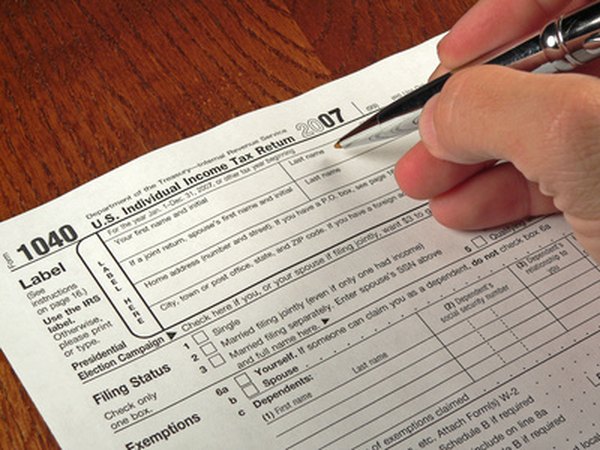SEP and IRA Hardship Withdrawal
Early withdrawals often incur the 10 percent additional tax penalty.
tax forms image by Chad McDermott from Fotolia.com
Though simplified employee pensions and individual retirement arrangements were designed for retirement, in hard financial situations, you may need to take a distribution from your SEP or IRA to make ends meet. The Internal Revenue Service rules allow you to remove money from your SEP or IRA at any time, for any reason. However, unless you meet the requirements for a hardship exception, you'll have to pay an early withdrawal penalty if you take out the money before turning 59 1/2 years old.
Early Withdrawal Penalties
Taking early distributions from SEPs and IRAs means you will have to pay taxes on any previously untaxed amounts. In addition the IRS may impose an additional 10 percent early withdrawal penalty on the taxable portion of the distribution if you take money out before turning 59 1/2. For example, if you take a $10,000 distribution, you'll owe an additional $1,000 in early withdrawal penalties on top of taxes owed. These penalties are calculated on Form 5329, which you attach to your income tax return.
Hardship Withdrawals
Qualifying for a hardship withdrawal from your SEP or IRA requires more than simply needing money because you lost your job or ran into an unexpected expense. The IRS has very strict rules about what withdrawals avoid penalties. These include suffering a permanent disability; excessive medical expenses; medical insurance costs if you've lost your job; paying for higher education expenses and purchasing a first home. Additional restrictions may apply within these categories.
Medical Insurance
If you are unemployed, you can avoid the early withdrawal penalty if you use the money to pay for your medical insurance premiums. To qualify, you must have lost your job and received unemployment benefits -- either state or federal -- for at least 12 weeks as a result. In addition, you have to take the distributions in the year you receive unemployment benefits or the following year, and you have to take the distribution no later than 60 days after you become employed again.
Higher Education Expenses
You can also avoid the penalty if you use the funds for higher education expenses. Qualified higher educational expenses include tuition and mandatory fees. If the student enrolls at least half-time, room and board also counts. However, you have to reduce the qualifying expenses by any tax-free aid, such as scholarships. For example, if your son has $15,000 in qualified expenses and receives a $3,000 scholarship, your exception only applies to up to $12,000 of distributions. You can be the student, or the student can be your spouse, child or grandchild.
First-Time Home Purchase
You can take out up to $10,000 penalty-free over your lifetime for first-time home purchases. You qualify as a first-time home buyer if neither you nor your spouse has owned a home within the past two years. In addition, you can use the exception for helping a child, grandchild, parent or grandparent purchase a first home, but the lifetime limit applies. For example, if your daughter qualifies as a first-time home buyer, and you use the exception for a $10,000 distribution, you can't later use the exception for your son because you've used your lifetime limit.
Roth IRA Differences
Roth IRA early withdrawals are taxed differently from traditional IRAs and SEPs, because Roth contributions are not deductible. When you take an early Roth IRA withdrawal, the amount attributable to your contributions isn't taxed or penalized because you already included them as taxable income when you made the contribution. Once you withdraw all of your contributions, you start taking out earnings. The earnings portion of an early withdrawal is taxable and subject to the 10 percent penalty. For example, imagine you have $30,000 in a Roth IRA and $20,000 comes from contributions. You could take out up to $20,000 tax-free and penalty-free. However, that last $10,000 counts as taxable income and the early withdrawal penalty applies. In addition to the 59 1/2 rule, Roth IRA accounts have to have been open for at least five years, starting from the first day of the year in which the first contribution was made.
References
Writer Bio
Based in the Kansas City area, Mike specializes in personal finance and business topics. He has been writing since 2009 and has been published by "Quicken," "TurboTax," and "The Motley Fool."

